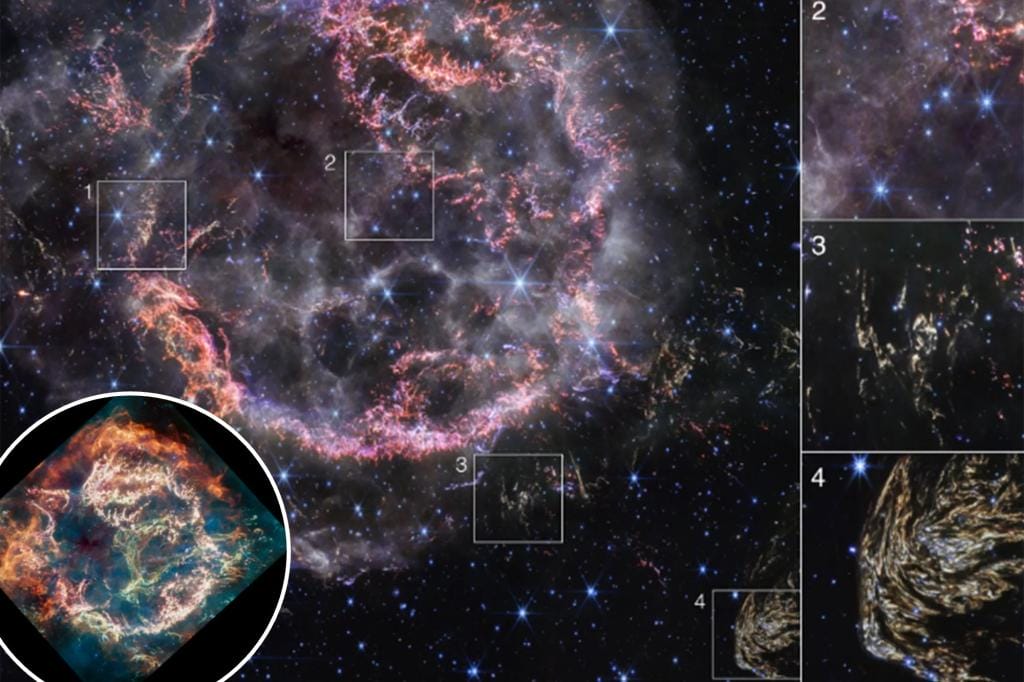They don’t call it a super-nova for nothing.
Just in time for the holidays, NASA released dazzling images of an exploding star that looks eerily like a shiny ornament placed on top of a Christmas tree.
The striking new image of Cassiopeia A (Cas A), which is located approximately 11,000 light-years from Earth and is one of the best-studied supernova remnants, was captured by the agency’s famed James Webb Space Telescope.
The telescope’s advanced near-infrared camera technology successfully captured the star’s explosion at a resolution that was previously unattainable.
“With NIRCam’s resolution, we can now see how the dying star completely shattered when it exploded, leaving behind filaments similar to small shards of glass,” Danny Milisavljevic of Purdue University, who leads the research team, said in a statement.
NIRCam’s resolution is capable of detecting small knots of gas, compounds of sulfur, oxygen, argon and neon from the star itself. NASA, ESA, CSA, STScI, D. Milisavljevic (Purdue University), T. Temim (Princeton University), I. De Looze (Gentle University).
“It’s really incredible, after all these years studying Cas A, to now be able to resolve those details, giving us a transformative view of how this star exploded.”
In the new NIRCam image, the colors of Cas A’s infrared light were translated into colors that were previously invisible to the human eye, allowing researchers to notice details that had never been seen before.
In particular, the clumps depicted in bright orange and light pink that form the inner layer of the supernova were exposed, showing the “smaller knots of gas” that will one day form new stars and planetary systems.
The Green Monster is invisible under NIRCam, but visible in the mid-infrared. NASA, ESA, CSA, STScI, D. Milisavljevic (Purdue University), T. Temim (Princeton University), I. De Looze (Gentle University)
The outskirts of the inner layer of Cas A, which exploded about 340 years ago from our point of view, also lit up in shades of deep orange and red in a way that resembles smoke from a campfire.
One aspect that has so far stumped researchers is the huge loop of green light that glowed bright green in the mid-infrared but disappeared under the NIRCam.
Nicknamed the “Green Monster,” the ionized gas is likely the result of supernova remnants pushing and sculpting gas left behind by the star before exploding.
Cassiopeia A is one of the best-studied supernova remnants. NASA, ESA, CSA, STScI, D. Milisavljevic (Purdue University), T. Temim (Princeton University), I. De Looze (Gentle University)
Additionally, NASA scientists were “absolutely stunned” to find a spot in the lower right corner of the camera view that “looks like an offspring of the parent supernova.”
Located about 170 light years behind the supernova remnant, Baby Cas A is a light echo, where light from the star’s long-ago explosion has reached and is heating distant dust, NASA said.
The incredible new images are just the latest in a series taken by the Webb telescope since it became operational last year.
One of the many celebratory images he posted showed a colorful close-up of a dozen stars at the moment of their birth, while another captured the final “performance” of a dying star in incredible detail.
Categories: Trending
Source: vtt.edu.vn
